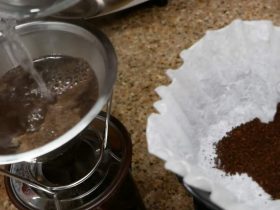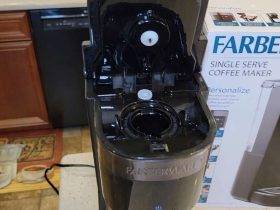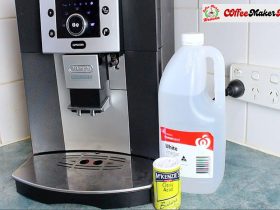Many of us have experienced this: we brewed a fresh cup of coffee, but reality intervened and prevented us from drinking it while it was still hot. We are now wondering, hours later, if we can reheat that cup of coffee in the microwave. While this may seem like a simple question, the answer is actually a bit more complicated. In this article, can you reheat coffee in the microwave? will explore this topic, discussing everything from potential health risks to the best techniques for achieving the perfect cup. Consequently, if you enjoy coffee and want to get the most out of your daily drink, keep reading to learn everything you need to know about reheating coffee in the microwave.
How do microwaves work?
Many homes all over the globe have microwave ovens as standard kitchen appliances. They were created in the early 1970s and provide a quick method to cook or reheat food and beverages.
Verônica Belchior is co-founder of the coffee educational project, The Coffee Sensorium. According to him, water molecules in food and drinks are cut by rotating microwave ovens. This creates a heat that is capable of cooking food.
The energy transfer to the water molecules comes from electromagnetic radiation. The radiation waves are reflected by the metal walls of the microwave, so they can be absorbed by the water molecules in food and drink.
Due to its powerful hydrogen and oxygen bonds, water has a high dielectric constant. In essence, this means that microwave radiation is readily absorbed by it. Vegetables and other foods with greater water content are better suited for microwaving.
Samo Smrke is Head of Coffee Processing at the Coffee Excellence Center at the Zurich University of Applied Sciences. He explains how coffee is reheated in the microwave.
Coffee is mostly water that absorbs microwaves. At the molecular level, radiation causes these water molecules to spin around and around faster. This gives them more energy, which means the temperature of the liquid increases.
Effects on flavor and aroma
We must first examine the chemistry of the volatile compounds in coffee in order to comprehend how microwaving affects the aromas and flavors of the coffee.
Our perception of coffee’s aromas and flavors is influenced by volatile molecules. These substances evaporate more rapidly because they have lower boiling points than nonvolatile substances. When coffee is ground or in touch with water, some volatile molecules instantly evaporate.
When coffee loses these volatile compounds, its chemical composition changes. This still happens when the coffee gets cold.
Verônica claims that heating coffee in a microwave increases the number of molecules’ chemical transformations. Additionally, it hastens the loss of other volatile compounds.
It is difficult to stop the loss of these volatile compounds because their behavior is affected by the heat produced by the rotation of the water molecules.
Microwave radiation has no direct impact on the coffee’s flavors and smells, according to Samo. Due to their lower dielectric constants than water, volatile compounds are less apt to absorb microwave radiation. In opposition to that, energy is transferred from the water molecules to the volatile substances. He compares the procedure to conductive heat transmission.
Many studies have been done to investigate how microwaves affect molecules. Most have found that there is only a heating effect, so microwaves do not have any significant specific effect on molecules,” he states.
On the other hand, it must be remembered that after the coffee has significantly cooled, more unfavorable tastes will start to develop. According to Verônica, coffee kept in a thermos or other container over time may promote the growth of microbes, and oxidative notes may also develop. She adds that the oxidation causes the coffee to taste stale and have off-flavors.
When coffee is made, some solubles, like carbohydrates, dissolve more readily in hot water, but as the liquid cools, the flavors become more pronounced. The return of these solubles is more pronounced the more total dissolved solids there are in the extraction.
When the coffee is heated again, some of these substances will disintegrate once more, but others won’t. Increased astringency, a lighter or thinner body, and a slimmer mouthfeel can all result from this.
Why does the bitterness increase?
Reheating coffee, whether in the microwave or by another method, is known to make the coffee taste more bitter.
Since chlorogenic acids are present, this is the case. These phenolic acids, which are a subset of aromatic phenolic acids, are present in large quantities in coffee leaves. These greatly influence the taste and fragrance of the coffee.
“Verônica says that heating up coffee releases caffeic and quinic acids by breaking down the chlorogenic acids.”
Samo draws attention to the connection between the perceptible rise in bitterness and how people perceive flavors. We notice the increased bitterness after reheating coffee because the acidity and sugar in coffee become much more apparent as it cools.
In addition, he adds that when brewed coffee is stored in closed containers for long periods of time, other flavor changes can occur upon reheating.
Since the container is closed, the aromas cannot escape, so the flavors may alter as a result of chemical reactions occurring in the coffee.
Other Products That Keep Your Coffee Warm
It seems like you’re always the one to let your coffee cool off. To preserve your coffee at the ideal drinking temperature, there are products on the market today.
Mug with a Lid
A mug with a lid on it is an easy way to keep your coffee warm. Your coffee will stay warm and cozy for a little while longer if you use something like a reusable cup. A further 30 minutes are preferable to nothing even though this won’t keep your coffee as warm as a thermal cup.
I presently use an Ecoffee Cup that is made of bamboo and has a silicone lid with a 12-ounce capacity. I like that it prolongs the life of my coffee while reducing waste that would otherwise wind up in landfills.
Thermal Mugs
For keeping your coffee hot, the thermal cup, which has been around for years, is ideal. They make great travel mugs for those early-morning trips!
An auto-seal lockable lid and ease of cleaning are important features to look for in a thermal cup that will keep your coffee warm. Your options will also vary depending on how long you want to keep your coffee warm. Look for a double-wall vacuum-insulated option, ideally made of stainless steel, to keep beverages warm for longer.
Although stainless steel costs more, if heat retention is important to you, this sort of thermal mug is for you.
The majority of makers claim that beverages will remain hot for four or more hours.
Smart Mug
Smart mugs are a more expensive choice in the mug market. The makers of these mugs claim that their products can maintain the temperature of your beverage for extended periods of time.

In the case of the Ember smart cup, it is anticipated that the battery life will be 2 hours when the mug is being used on the go and at a predetermined temperature. The desired temperature, ambient temperature, and pour temperature are just a few of the variables that can impact battery life.
Through an app on your phone, the smart mugs link to your phone (or Apple Watch). You’ll be able to regulate the warmth and keep tabs on your caffeine intake thanks to this. If the beverage is too hot, an LED on the edge will alert you. In general, smart cups must be hand-washed after use because they are not dishwasher safe.
If you don’t care about flavor and only want energy, it’s okay to reheat coffee in the microwave. If the flavor of your coffee is essential to you, you might want to consider heating it up on the stove or getting a mug that will keep it warm for longer.
Read More: How much electricity does a Bunn coffee maker use?
Frequently Asked Quenstions
What is the best way to reheat coffee?
The best way to reheat coffee is to pour it into a microwave-safe container and heat it in the microwave for 30 seconds to a minute, depending on the strength of the microwave and the amount of coffee. Alternatively, you can heat it on the stove in a small saucepan over low heat, stirring constantly until it reaches the desired temperature. It is important not to overheat the coffee as it can affect its taste and quality.
Does microwaving coffee destroy the caffeine?
90 seconds in a microwave causes coffee to lose 80-80% of its antioxidant strength. Although frequent reheating will diminish the taste of most coffees, it won’t eliminate the caffeine.
Is it wrong to microwave coffee?
No, it is not wrong to microwave coffee. However, microwaving coffee can alter its taste and aroma, so some people prefer not to do it. Additionally, it is important to be careful when microwaving coffee as it can become very hot and cause burns.
What can be affected by reheating coffee?
Reheating coffee can affect its taste, aroma, and chemical composition. The reheating process can cause the coffee to become bitter, stale, and lose its original flavor and aroma. Additionally, reheating can also increase the acidity levels and alter the chemical structure of the coffee, leading to potential health risks.














Leave a Reply